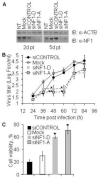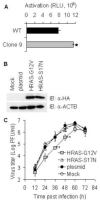Alphavirus production is inhibited in neurofibromin 1-deficient cells through activated RAS signalling
- PMID: 18485440
- PMCID: PMC3280685
- DOI: 10.1016/j.virol.2008.03.025
Alphavirus production is inhibited in neurofibromin 1-deficient cells through activated RAS signalling
Abstract
Virus-host interactions essential for alphavirus pathogenesis are poorly understood. To address this shortcoming, we coupled retrovirus insertional mutagenesis and a cell survival selection strategy to generate clonal cell lines broadly resistant to Sindbis virus (SINV) and other alphaviruses. Resistant cells had significantly impaired SINV production relative to wild-type (WT) cells, although virus binding and fusion events were similar in both sets of cells. Analysis of the retroviral integration sites identified the neurofibromin 1 (NF1) gene as disrupted in alphavirus-resistant cell lines. Subsequent analysis indicated that expression of NF1 was significantly reduced in alphavirus-resistant cells. Importantly, independent down-regulation of NF1 expression in WT HEK 293 cells decreased virus production and increased cell viability during SINV infection, relative to infected WT cells. Additionally, we observed hyperactive RAS signalling in the resistant HEK 293 cells, which was anticipated because NF1 is a negative regulator of RAS. Expression of constitutively active RAS (HRAS-G12V) in a WT HEK 293 cell line resulted in a marked delay in virus production, compared with infected cells transfected with parental plasmid or dominant-negative RAS (HRAS-S17N). This work highlights novel host cell determinants required for alphavirus pathogenesis and suggests that RAS signalling may play an important role in neuronal susceptibility to SINV infection.
Figures




Similar articles
-
NF-κB Activation Promotes Alphavirus Replication in Mature Neurons.J Virol. 2019 Nov 26;93(24):e01071-19. doi: 10.1128/JVI.01071-19. Print 2019 Dec 15. J Virol. 2019. PMID: 31554691 Free PMC article.
-
High-Throughput Fluorescence-Based Screen Identifies the Neuronal MicroRNA miR-124 as a Positive Regulator of Alphavirus Infection.J Virol. 2020 Apr 16;94(9):e02145-19. doi: 10.1128/JVI.02145-19. Print 2020 Apr 16. J Virol. 2020. PMID: 32102877 Free PMC article.
-
Identification and Characterization of Sindbis Virus RNA-Host Protein Interactions.J Virol. 2018 Mar 14;92(7):e02171-17. doi: 10.1128/JVI.02171-17. Print 2018 Apr 1. J Virol. 2018. PMID: 29321325 Free PMC article.
-
The Regulation of Translation in Alphavirus-Infected Cells.Viruses. 2018 Feb 8;10(2):70. doi: 10.3390/v10020070. Viruses. 2018. PMID: 29419763 Free PMC article. Review.
-
Neuronal cell death in alphavirus encephalomyelitis.Curr Top Microbiol Immunol. 2005;289:57-77. doi: 10.1007/3-540-27320-4_3. Curr Top Microbiol Immunol. 2005. PMID: 15791951 Review.
Cited by
-
A molecular understanding of alphavirus entry.PLoS Pathog. 2020 Oct 22;16(10):e1008876. doi: 10.1371/journal.ppat.1008876. eCollection 2020 Oct. PLoS Pathog. 2020. PMID: 33091085 Free PMC article. Review.
References
-
- Altschul SF, Gish W, Miller W, Myers EW, Lipman DJ. Basic local alignment search tool. J Mol Biol. 1990;215(3):403–10. - PubMed
-
- Boyanapalli M, Lahoud OB, Messiaen L, Kim B, Anderle de Sylor MS, Duckett SJ, Somara S, Mikol DD. Neurofibromin binds to caveolin-1 and regulates ras, FAK, and Akt. Biochem Biophys Res Commun. 2006;340(4):1200–8. - PubMed
-
- Corral T, Jimenez M, Hernandez-Munoz I, Perez de Castro I, Pellicer A. NF1 modulates the effects of Ras oncogenes: evidence of other NF1 function besides its GAP activity. J Cell Physiol. 2003;197(2):214–24. - PubMed
Publication types
MeSH terms
Substances
Grants and funding
LinkOut - more resources
Full Text Sources
Research Materials
Miscellaneous

